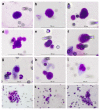Subpopulations of Circulating Cells with Morphological Features of Malignancy Are Preoperatively Detected and Have Differential Prognostic Significance in Non-Small Cell Lung Cancer
- PMID: 34503298
- PMCID: PMC8431290
- DOI: 10.3390/cancers13174488
Subpopulations of Circulating Cells with Morphological Features of Malignancy Are Preoperatively Detected and Have Differential Prognostic Significance in Non-Small Cell Lung Cancer
Abstract
Background: Non-small cell lung cancer (NSCLC) frequently presents when surgical intervention is no longer feasible. Despite local treatment with curative intent, patients might experience disease recurrence. In this context, accurate non-invasive biomarkers are urgently needed. We report the results of a pilot study on the diagnostic and prognostic role of circulating tumor cells (CTCs) in operable NSCLC.
Methods: Blood samples collected from healthy volunteers (n = 10), nodule-negative high-risk individuals enrolled in a screening program (n = 7), and NSCLC patients (n = 74) before surgery were analyzed (4 mL) for the presence of cells with morphological features of malignancy enriched through the ISET® technology.
Results: CTC detection was 60% in patients, while no target cells were found in lung cancer-free donors. We identified single CTCs (sCTC, 46%) and clusters of CTCs and leukocytes (heterotypic clusters, hetCLU, 31%). The prevalence of sCTC (sCTC/4 mL ≥ 2) or the presence of hetCLU predicted the risk of disease recurrence within the cohort of early-stage (I-II, n = 52) or advanced stage cases (III-IVA, n = 22), respectively, while other tumor-related factors did not inform prognosis.
Conclusions: Cancer cell hematogenous dissemination occurs frequently in patients with NSCLC without clinical evidence of distant metastases, laying the foundation for the application of cell-based tests in screening programs. CTC subpopulations are fine prognostic classifiers whose clinical validity should be further investigated in larger studies.
Keywords: cancer biomarkers; circulating tumor cells; early diagnosis; lung cancer.
Conflict of interest statement
The study funders had no role in the design of the study, the collection, analysis, and interpretation of the data, the writing of the manuscript, and the decision to submit the manuscript for publication. The authors declare no competing non-financial interests but the following competing financial interest: G.V. received honoraria from Ab Medica SpA (Milan, Italy). All the other Authors declare no conflict of interest.
Figures




References
-
- Campbell J.D., Alexandrov A., Kim J., Wala J., Berger A.H., Pedamallu C.S., Shukla S.A., Guo G., Brooks A.N., Murray B.A., et al. Distinct patterns of somatic genome alterations in lung adenocarcinomas and squamous cell carcinomas. Nat. Genet. 2016;48:607–616. doi: 10.1038/ng.3564. - DOI - PMC - PubMed
-
- Walters S., Maringe C., Coleman M., Peake M.D., Butler J., Young N., Bergström S., Hanna L., Jakobsen E., Kölbeck K., et al. Lung cancer survival and stage at diagnosis in Australia, Canada, Denmark, Norway, Sweden and the UK: A population-based study, 2004–2007. Thorax. 2013;68:551–564. doi: 10.1136/thoraxjnl-2012-202297. - DOI - PubMed
-
- Allemani C., Matsuda T., Di Carlo V., Harewood R., Matz M., Nikšić M., Bonaventure A., Valkov M., Johnson C.J., Estève J., et al. Global surveillance of trends in cancer survival 2000–14 (CONCORD-3): Analysis of individual records for 37 513 025 patients diagnosed with one of 18 cancers from 322 population-based registries in 71 countries. Lancet. 2018;391:1023–1075. doi: 10.1016/S0140-6736(17)33326-3. - DOI - PMC - PubMed
Grants and funding
LinkOut - more resources
Full Text Sources

